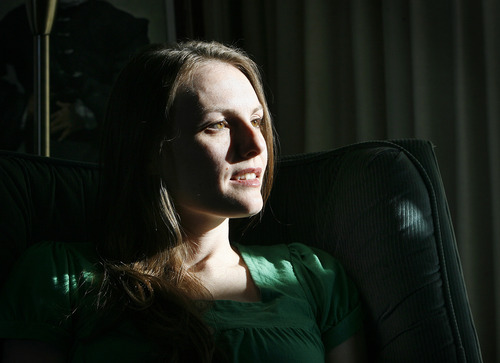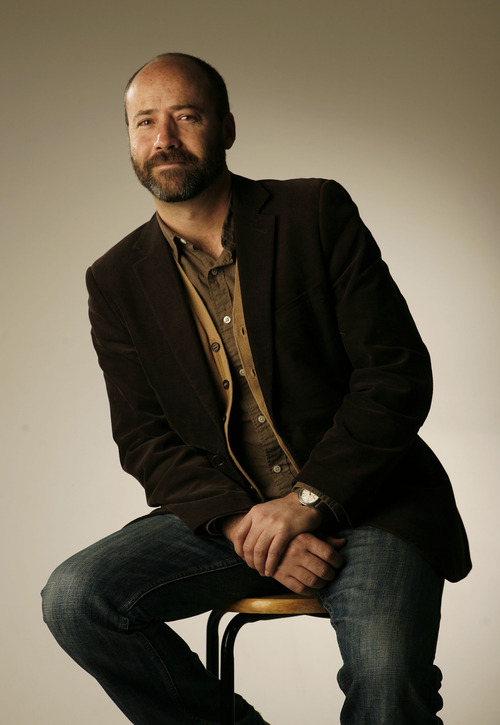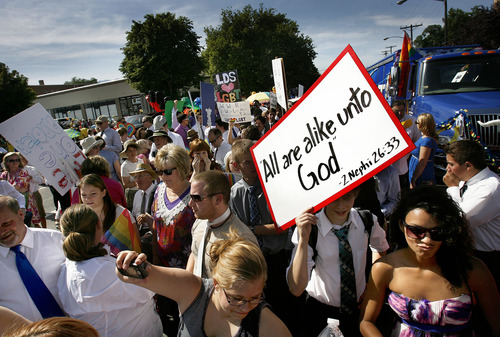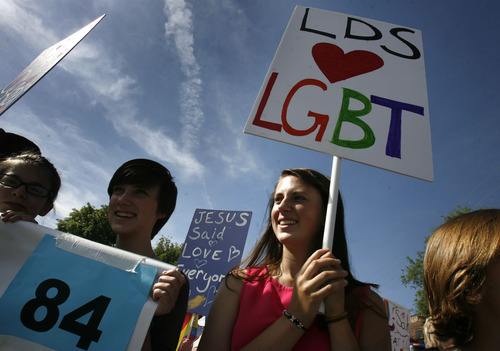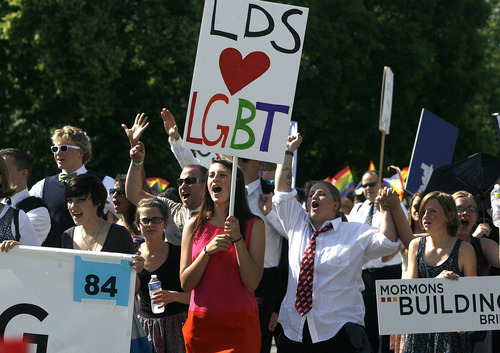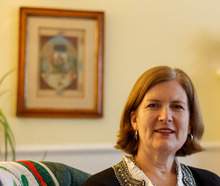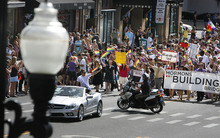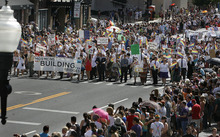This is an archived article that was published on sltrib.com in 2013, and information in the article may be outdated. It is provided only for personal research purposes and may not be reprinted.
Call it the "Gay Mormon Moment."
After years of tension between Latter-day Saints and gay rights activists — with political action and theological pronouncements on one side, protests and pain on the other — the gulf between the two groups has begun to narrow.
The Church of Jesus Christ of Latter-day Saints has acknowledged that homosexuality is neither a choice nor a sin. It has supported anti-discrimination ordinances in Utah communities, stayed away from the 2012 battles against same-sex marriage in four states, and launched a website to soften the rhetoric about homosexuality and allow gay Mormons to tell their stories.
In the midst of that warming trend came more than 300 straight Mormons in their Sunday best, marching in Utah's 2012 Gay Pride Parade, right behind "Milk" screenwriter Dustin Lance Black and before the drag queens.
They called themselves Mormons Building Bridges. They were not out to debate politics or doctrine, organizers said, but to promote love and listening. Still, their simple yet potent gesture echoed around the globe, setting an example for fellow believers who then took up the style, if not the name, in 15 other Pride parades. They also attracted national and international media attention, well-known enough even for spoofing in the satirical magazine The Onion.
They are The Salt Lake Tribune's Utahns of the Year for 2012.
"It feels like something clicked in June 2012," says John Gustav-Wrathall, an excommunicated gay Mormon in a long-term same-sex relationship who nonetheless regularly attends weekly LDS services in Minneapolis. "This was a galvanizing moment. It fired everyone up."
Mormons typically view Gay Pride Parades "with loathing and disdain," says Gustav-Wrathall, who became involved early on with Bridges. "It was electrifying that there would be a large contingent marching in Salt Lake City. And I figured if they can do that there, we can do it anywhere."
Attending church feels different now, he says. "The mood has shifted, a new tone has been struck. It is now safe for Mormons to talk openly about homosexuality, and Mormons Building Bridges played a key role in that."
Erika Munson, a straight, married Mormon mom who moved to Utah from Connecticut in 2009 and came up with the Bridges' idea, is a reluctant revolutionary.
Like other Latter-day Saints, Munson was troubled by her church's highly publicized push for California's Proposition 8, defining marriage as exclusively between a husband and a wife. She watched helplessly as gays left the faith, resigned to the fear that there seemed to be no place for them in the pews.
And she saw her children struggle with the dissonance between the church's teachings about love and what they saw as its rejection of LGBT fellow believers.
In January, Munson decided she needed to do something, anything, so when she learned that the Pride Parade was the second largest in the state — after the Days of '47 Parade — she impulsively reserved a space.
As the date drew nearer, Munson enlisted award-winning Mormon filmmaker Kendall Wilcox and his co-producer Bianca Morrison Dillard to help with strategy and organizing.
Wilcox, a well-respected gay Mormon who last year began filming interviews with LGBT members, sensed Bridges' potential. He helped Munson clarify the group's mission and became an invaluable liaison with the LGBT community.
"There is an exponentially growing number of Mormon hearts that are turning toward compassion," he says. "We turned that into action."
Dillard, a straight, active, married Mormon in Provo, also signed on enthusiastically, bringing grass-roots organizing skills to the movement.
During the Prop 8 campaign, Dillard "didn't know what to make of all the gay Mormon stuff, so I ducked and covered. I kept my distance," she says. "But it didn't sit well."
Organizers knew there might be push-back against Bridges from the LGBT community.
After all, for years the LDS Church considered homosexuality itself a sin, encouraged young gay men to marry women and supported efforts such as "reparative therapy" as a way of changing same-sex orientation.
Members of the gay community felt misunderstood, wounded and attacked. Would anyone expect them to embrace the very people many saw as their tormenters?
Wilcox, who worked at LDS Church-owned Brigham Young University for years, had a well of empathy, but knew that, without gay participation, Bridges would have been a bridge to nowhere.
"Mormons are coming in peace," he told them. "We don't have all the answers."
Dillard also worried about the LGBT response.
For some Pride participants, Mormons showing up at their parade and not advocating for marriage equality "is not enough," she says, "and I get that."
The LDS Church's new website — mormonsandgays.org — reaffirms that "same-sex attraction is not a sin … acting on it is," and Mormon leaders still insist that sex should be only between a husband and a wife.
Well aware of the gay community's concerns, Munson attended a Pride planning meeting about a week before the parade. She listened politely and finally raised her hand and said: "A bunch of Mormons are planning to march in our Sunday dress. Is that OK? Will we be intruding?"
Troy Williams, radio host, writer and Salt Lake City gay rights proponent, likewise was worried about Bridges' participation.
"I went to that fear place immediately," he says, warning Munson, "You'll be booed and harassed."
Even so, Williams backed the idea at the Utah Pride Center and with grand marshal Black, who embraced it and insisted on putting Bridges at the front of the parade.
In the end, the positive response proved overwhelming.
Up and down the Salt Lake City parade route, the crowd cheered, clapped and, yes, cried.
"It was," Williams says, "one of the most beautiful moments of my life."
Certainly not everyone applauded. Plenty of LGBT members complained that the Mormon march was "too little, too late," Wilcox says.
But the parade wasn't the end of Bridges' outreach, merely a high-profile beginning. Now came the hard work: moving from symbol to substance.
The goal became creating a safe place for gay people at church and providing Mormons with tools to open the conversation with their LGBT friends and family.
Bridges' founders and a 12-member steering committee maintain a lively Facebook page, where people can share their stories and get information. They disseminate a "Family Acceptance" pamphlet, aimed at helping Mormon families respond in loving ways to gay family members, and encourage members to show it to their local LDS leaders.
They created LDS "outreach firesides," where Mormon members and leaders can meet with gays. They established a "safe and sound" program for homeless gay teens.
They named Dec. 23 as "Sit By Me Sunday," urging all Bridges' supporters to bring a gay person to church with them. And they launched One Voice Choir, featuring LGBT and straight Mormon singers, making sacred music together.
"I don't know what will happen to gays in the eternities and I am OK with that," Dillard says, "but what we do know is that Christ asked us to love each other, especially the disenfranchised. I feel that I can do that."
Plans are already under way for the 2013 Gay Pride Parade.
They have commissioned a float with the words "Families Together," and are asking straight Mormons and gays to march in pairs — each churchgoer walking side by side with a gay friend or family member; each gay person inviting their most resistant homophobic relative.
"I want the church's highest leaders to see their members march in the parade and being cheered," Williams says. "We are their grandchildren, their nephews and nieces. It is time for this wedge [between us] to go away."
These Utahns of the Year, he says, "are marching Mormonism into the 21st century."
Past Salt Lake Tribune Utahns of the Year
2011 • Salt Lake City Police Chief Chris Burbank
2010 • Kidnapping survivor Elizabeth Smart, her mother, Lois, and her sister, Mary Katherine
2009 • Kidnapping survivor Elizabeth Smart
2008 • Utah entrepreneur and philanthropist Larry H. Miller
2007 • First responders to tragedies, including the Trolley Square shooting rampage and the Crandall Canyon Mine disaster
2006 • Latino leaders Jorge Fierro, Andrew Valdez, Ruby Chacon and Alma Armendariz
2005 • Pamela Atkinson, advocate for the poor
2004 • Utahns killed in Iraq and Afghanistan
2003 • Utah Gov. Olene Walker
2002 • LDS Church President Gordon B. Hinckley
2001 • 2002 Winter Games organizer Mitt Romney
2000 • Salt Lake City Mayor Rocky Anderson
1999 • The letter that sparked the Olympic bribery scandal
1998 • M. Kingston, who suffered a brutal beating after escaping plural marriage
1997 • NBA MVP Karl Malone —
Readers agree
Mormons Building Bridges also was the top vote-getter in our reader poll for Utahn of the Year, finishing just ahead of former Gov. Jon Huntsman and retired federal Judge Samuel Alba. Also in the top five were Carol Masheter, who scaled every continent's highest peak after taking up climbing in her 50s, and the Utah firefighters who fought last summer's wildfires.



